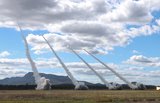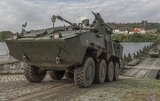Australia looks towards space with force restructure, investment and training
Australia is looking to improve its presence in space with a focus on communications and creating a dedicated segment of its defence forces committed to the domain.
General Dynamics C4 Systems has announced that it recently demonstrated wireless high definition video and data transfer to US government customers using the Wideband Networking Waveform (WNW) on the JTRS HMS AN/PRC-155 two-channel networking manpack radio. General Dynamics funded the implementation of the waveform using the same manpack hardware currently being produced under the JTRS HMS programme of record.
WNW delivers ‘unprecedented’ capacity, speed and connectivity for voice, data and other large files moving through mobile tactical networks, the company said.
The JTRS HMS programme has been designed to incorporate new waveforms, and as one of three networking waveforms in the JTRS library, WNW provides the backbone function needed to seamlessly transport large amounts of data across the tactical network. A waveform provides the transport of information through a network including the physical signal, protocols and security as well as routing functions.
The Soldier Radio Waveform (SRW) delivers networked voice and data communications for individual soldiers and edge devices that have tight size, weight and power requirements. The Mobile User Objective System (MUOS) waveform enables satellite communications and leverages advanced wireless technology that is similar to terrestrial cellular communications.
Chris Marzilli, president of General Dynamics C4 Systems, said, ‘WNW is running on the same radio hardware that we are shipping to the army today so this is unlike any manpack offering on the market. The powerful waveform can also run on radios that fit into small vehicular installations as well as those used by dismounted soldiers; the PRC-155 Manpack is the only tactical radio to demonstrate the successful use of all three networking waveforms: SRW, WNW and MUOS.’
General Dynamics C4 Systems is the prime contractor of the JTRS HMS radio programme, which includes the two-channel PRC-155 networking manpack radio. Currently in low rate initial production, the radio is now in Multiservice Operational Test and Evaluation at Network Integration Exercise 12.2 in support of a full rate production decision scheduled for later this year.

Australia is looking to improve its presence in space with a focus on communications and creating a dedicated segment of its defence forces committed to the domain.

The Portuguese company’s naval communications system is in service across more than a dozen countries. It has turned to its home nation for support in developing a new vehicle based C2 system.

The Vision4ce Deep Embedded Feature Tracking (DEFT) technology software is designed to process video and images by blending traditional computer vision with artificial intelligence (AI) algorithms to present actionable information from complex environments.

Persistent Systems has been cleared by National Security Agency (NSA) to transmit sensitive data on commercial networks. The devices are added to the NSA’s Commercial Solutions for Classified (CSfC) component list which also includes other companies’ products providing the same security.

The release of the UK’s Strategic Defence Review (SDR) has been long promised as mid-year. It is possible it could be as early as 2 June although the UK Ministry of Defence (MoD) continues to play its cards close to its chest.

Intelsat outlines how its multi-orbit SATCOM architecture is enhancing connectivity and resilience for special operations forces operating in degraded and contested environments.